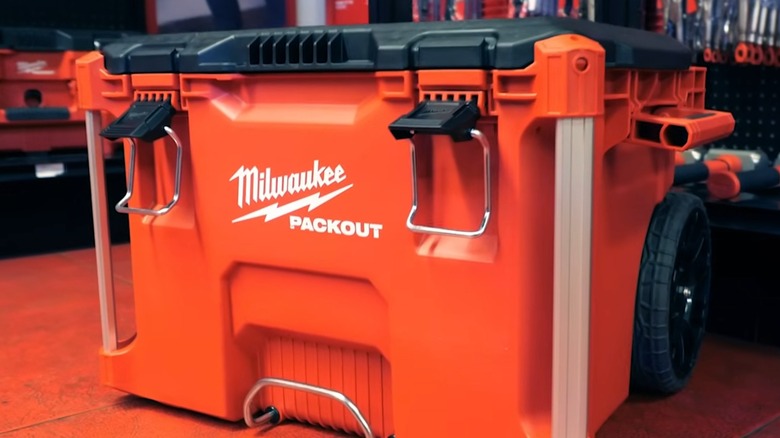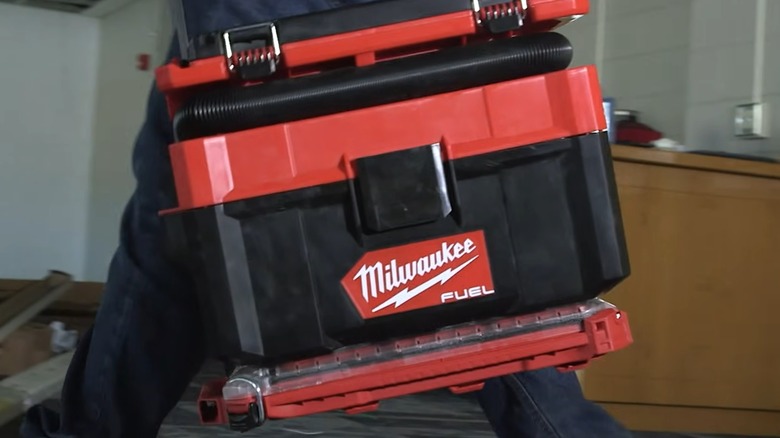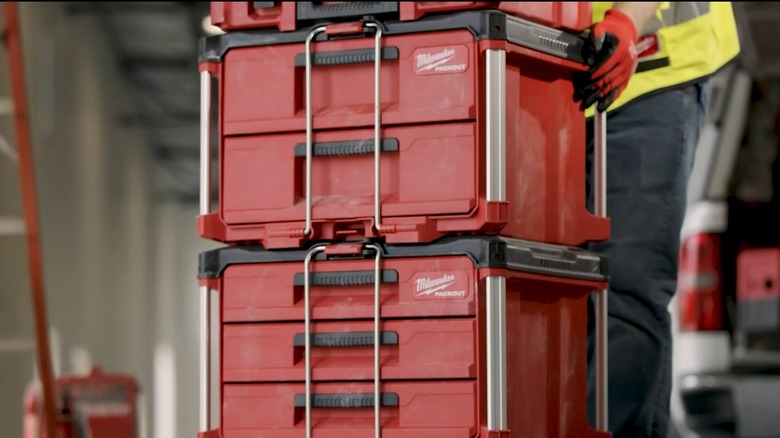Can You Take A Milwaukee Packout On A Plane?
When it comes to Milwaukee's Packout line of storage containers, versatility is the name of the game. You can stack them as you see fit, and squeeze a host of different tools within them for effective storage. Not to mention, they're excellent when it comes to moving tools from job to job. There are even a host of cool Milwaukee Packout mods worth checking out, if you want to get even more out of the system. Better yet, if you're looking to do some long-distance traveling and want to take your Packout with you, you're more than able to do so.
In recent decades, airlines and the Transportation Security Administration (TSA) have become more thorough about what they allow in the air. Thus, one might think that such a massive, heavy-duty item as a Milwaukee Packout box would be a no-go on a plane. As it turns out, it's entirely possible to bring such a container along for your trip like any other suitcase. Given the size of most containers, they're not ideal for carry-on purposes, though they're a good alternative for more traditional forms of checked luggage. They lock, are undoubtedly durable, and many have wheels, after all.
With all of that said, there are a few reasons why you might not want to bring your Milwaukee Packout case, or cases, on a plane. That is, unless you don't mind paying up.
Air travel with one or more Packout cases can get expensive
As noted, at first glance, Milwaukee Packout containers seem to make perfect luggage alternatives. They're built to last, you can roll them around the airport with ease, and you don't have to worry about them accidentally opening. Some Packout containers are even highly-rated among users thanks to their prices, so they're not too absurdly expensive to get. At the same time, they could end up costing you extra in the long run. Some have reported that if you want to bring multiple Packout cases on your flight, despite their modularity, odds are they'll have to be checked in as separate cases. As a result, you'll end up paying more to have all of your luggage brought aboard.
If you just plan on using one Packout container for your trip, you're not out of the woods either. Looking at the average Packout rolling tool box, such a unit weighs 24 pounds on its own. Adding whatever you may need for your trip is only going to make that container heavier. The likes of American Airlines, Delta, and other major names have different weight thresholds that result in additional costs, so as great as Packout containers are at keeping your tools safe during travel, even a single one could be a sizable expense. If the financial cost is not a concern, or if you simply have to transport your tools for work, there are steps worth taking to make it as easy and hassle-free as possible.
Recommended prep for traveling with Packout containers
Flying with a hefty, tool-filled Milwaukee Packout, there are things to consider. Some who have flown their work equipment in such containers, offer helpful advice. "If you have to send tools as luggage remove anything handlers can break and make them as easy for TSA to access as possible. Other than that, insure them or make sure your employer will replace them when they get stolen," recommended one Redditor.
In another thread concerning flying with tools in a Packout, u/polev28, a Delta baggage handler, mentioned that lithium-ion batteries should be removed and placed in a carry-on. This may sound surprising, but lithium-ion batteries don't count among the electronics the TSA doesn't allow in carry-on baggage. Highlighting tool safety, u/studlife added, "Make sure you stuff it full. I put shoes & other things in there to insure stuff won't shift & bang around in transit." u/mtnfreak88 also touched on the importance of adding a TSA lock, this way the locking mechanism of your Packout isn't damaged should TSA officials need to open it up for inspection.
Milwaukee's Packout containers are relied upon by tradesmen, with many finding them essential for moving their tools around. This even goes for those who frequently fly, despite the hurdles that can come during air travel with such containers.


